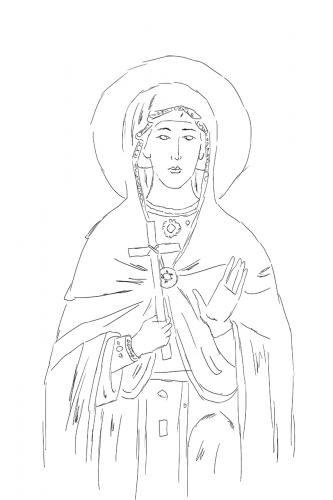



Sfânta Eupraxia
Legenda hagiografică o plasează pe Sfânta Eupraxia în înalta aristocraţie bizantină de la curtea lui Teodosie cel Mare, sfârşitul secolului al IV-lea. Încă de la vârsta de 7 ani, Eupraxia, împreună cu mama sa văduvă, pleacă de la Constantinopol în Egipt, pentru a se alătura unei aşezări cenobitice feminine. De la sosirea sa, copila se dedică lui Hristos, alegând să intre într+o mănăstire, renunţând la o avere considerabilă. Legenda enumără o serie de accidente şi răniri pe care Eupraxia le-ar fi suferit din cauza diavolului care încerca să o împiedice să lucreze. În preajma vârstei de 30 de ani Eupraxia moare şi începe să fie venerată pentru viaţa ei dedicată ascezei.
Din punct de vedere iconografic, Eupraxia nu se diferenţiază de grupul celorlalte sfinte cuvioase, majoritatea fecioare juruite vieţii mănăstireşti sau chiar celei cenobitice: prezentată frontal, bust, sau în picioare, purtând o cruce în mâna dreaptă ca mărturisitoare a credinţei, acoperită de o mantie întunecată ce îi acoperă şi capul şi îi ascunde părul, semn al vieţii ascetice. Ce o diferenţiază pe Eupraxia de grupul celorlalte cuvioase este că adeseori sub mantie sunt viyibile bogate veşnimte aulice bizantine, subliniind rangul, bogăţia şi privilegile pe care le-a părăsit pentru a îşi duce viaţa în pustie.
Legenda hagiografică o plasează pe Sfânta Eupraxia în înalta aristocraţie bizantină de la curtea lui Teodosie cel Mare, sfârşitul secolului al IV-lea. Încă de la vârsta de 7 ani, Eupraxia, împreună cu mama sa văduvă, pleacă de la Constantinopol în Egipt, pentru a se alătura unei aşezări cenobitice feminine. De la sosirea sa, copila se dedică lui Hristos, alegând să intre într+o mănăstire, renunţând la o avere considerabilă. Legenda enumără o serie de accidente şi răniri pe care Eupraxia le-ar fi suferit din cauza diavolului care încerca să o împiedice să lucreze. În preajma vârstei de 30 de ani Eupraxia moare şi începe să fie venerată pentru viaţa ei dedicată ascezei.
Din punct de vedere iconografic, Eupraxia nu se diferenţiază de grupul celorlalte sfinte cuvioase, majoritatea fecioare juruite vieţii mănăstireşti sau chiar celei cenobitice: prezentată frontal, bust, sau în picioare, purtând o cruce în mâna dreaptă ca mărturisitoare a credinţei, acoperită de o mantie întunecată ce îi acoperă şi capul şi îi ascunde părul, semn al vieţii ascetice. Ce o diferenţiază pe Eupraxia de grupul celorlalte cuvioase este că adeseori sub mantie sunt viyibile bogate veşnimte aulice bizantine, subliniind rangul, bogăţia şi privilegile pe care le-a părăsit pentru a îşi duce viaţa în pustie.




